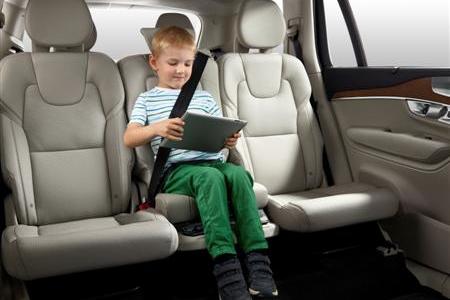Volvo makes a call for car makers to do more to assist in reducing
child fatalities
|
 Volvo's integrated booster cushion
Volvo's integrated booster cushion
|
|
|
Home >
News >
Volvo
Recent new car releases ..... here
Upcoming new car releases ..... here
10th May, 2015
- Volvo marks 25th anniversary of integrated booster cushion for kids
Volvo Car Australia used UN Global Road Safety Week (4-10 May) to appeal to other car makers to take more
responsibility to help save children’s lives by incorporating child safety systems into vehicle development.
The call from Volvo’s Australian Managing Director Kevin McCann comes on the 25th anniversary of the launch of the
world’s first integrated booster cushion for children. Launched by Volvo in 1990, the booster cushion is acknowledged as
a major step forward in child safety.
“According to the World Health Organisation, 500 children are killed every day in road accidents around the world –
that’s nearly 187,000 children every year. Traffic injuries rank among the top four causes of death among children.
“To reduce this tragic toll Volvo believes other car makers should join us in leading the development of child
safety systems as a part of vehicles to ensure the best performance. Children are our future – and we feel strongly that
they should be given the best when it comes to safety.”
McCann said Volvo has taken the lead in child safety globally by incorporating safety features in its cars, such as
the world’s first child seat, the first rear-facing child seat, and the integrated booster cushion.
To this day, booster seats play an integral role in keeping children safe in cars. Though there are slight variations,
in most Australian states children aged over 7 can legally be secured by an adult seatbelt, though Volvo encourages
boosters being used for a longer period of time.
According to Volvo, once over the age of 3 or 4, children who sit facing forward should use a booster cushion until
they are 140cm tall and 10 years old. “One of the key benefits of integrated booster cushions is that it is developed
as a part of the seat and the safety belt is in more direct contact with the child’s body, removing the possibility of
‘slack’ in the belt that could be associated with accessory booster cushions/seats or child seats,” said Mr McCann.
A history of Volvo’s car seats for kids
|
|
|

Self-Catering Holiday
Accommodation in
Denmark, WA
..... more
|
|
|
1964 — First child seat prototype
Inspired by how astronauts travel rearwards, Volvo was closely involved in the development and testing of the very
first child seat prototype.
1967 — Reversible front passenger seat
The first child seat to be sold to customers was made by turning the front passenger seat around. Adding a padded
backrest with straps made sure that the rear-facing child was kept in place. The solution was sold as an accessory for
the Volvo Amazon.
1972 — Volvo’s first rear-facing child seat
Rear-facing child seats are designed to support the neck and help spread the force of a frontal impact over a larger
area. Frontal impacts are the most frequent and usually the most severe impact situation.
E&OE.
|